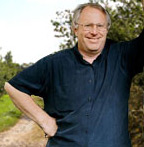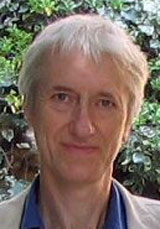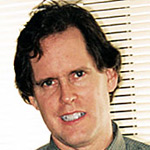This sequence began with a telephone inquiry from James Crowden of Winsham, near Chard, to Gabrielle Wilson, the Clerk to Wrington Parish Council. James is interested in Thomas De Quincey, the 19C English essayist and opium addict. De Quincey's mother built a house she called 'West Hay', and James wanted to know if it was still in existence. His inquiry was passed to the website, which led to another telephone call and series of e-mails.
|
 From James Crowden, 11th December, 2008 From James Crowden, 11th December, 2008
Many thanks for the chat. I enclose scans from Grevel Lindop's book which was published in 1985. Mrs Quincey was building her 'mansion' in about 1806/1807 I think... The rest you can perhaps deduce from the pages 181-184. Certainly Thomas stayed there for a few months and visited his mother on and off.
The academic in Canada is Robert Morrison - see his Thomas De Quincey website
www.queensu.ca/english/tdq/index.html
Mrs Quincey died in 1846 aged 90, and I think was still living at West Hay, so she lived in Wrington for at least 40 years and may have been there earlier still.
Any information about the present state of West Hay or who owns it or any other bits of info which would be greatly appreicated by Robert. I assume it will exist on the 1829 Tithe map and may well show Mrs Quincey as incumbent. She put the 'De' in front of the Quincey to make it sound more upper crust... De Quincey..
If you want to use any of this information on the webiste I am sure that will be Ok, but it should be perhaps be cleared with Prof Grevel Lindop in Manchester as some of it may have to be also cleared with the publishers as it is still in copyright.
No doubt there will be more with Robert's new book which will be published in December, 2009.
So Wrington has not just an airport and a brewery, John Locke and Hannah More, but an opium addict's mother who got through three fortunes in her lifetime ..... I think it's a rich vein of local Wrington which deserves to be tapped..
For instance : Mrs Elizabeth Quincey is briefly mentioned in Anne Stott's book on Hannah More, page 296, as helping Hannah with petitioning etc, etc, and HM refers to her as her 'valuable neighbour'.
Best wishes and many thanks in advance..
|
 From Grevel Lindop, 11th December, 2008 From Grevel Lindop, 11th December, 2008 |
|
I'd be delighted for you to use the pages on your website. There is also other related material in the edition of De Quincey's works which I edited some years ago. For example, a long passage about the use of water diviners in the Wrington Vale, without which De Quincey claimed it was impossible for people to find adequate water supplies for a house. I'll try to get this material for you.
If you quote any extracts from my biography or from my edition of the Works, could you please give the source and my name, and include a link to my website, which is
www.grevel.co.uk
Many thanks and I'll be fascinated to see the results in due course!
|
|
 From Robert Morrison, 12th December, 2008: From Robert Morrison, 12th December, 2008:
Grevel Lindop has asked me to send you the reference in De Quincey's 1856 version of Confessions of an English Opium-Eater to the 'tea-kettles in the vale of Wrington'. I attach two images.
The first is the title page from Grevel's recent edition of both the 1821 and the 1856 versions of Confessions.
The second is page 152 of this edition, where the Wrington reference appears (please ignore my pencil markings in the margins). I hope this information is helpful. Please let me know if you have any questions. Full bibliographical information on the new De Quincey edition is available at the following address:
www.pickeringchatto.com/major_works/the_works_of_thomas_de_quincey.
|
[e-mail sent to James Crowden 12th December, 2008 telling him that local historian, Joyce Smith has slides of West Hay taken in the late 1950s/early 60s by her husband, Hugh, which will be scanned and sent shortly - Ed]
|
|
From James Crowden, 12th December, 2008
Excellent. In fact Thomas only lived there for a few months during the final constructiion phase and then only visited periodically when he was in the area. He didn't approve of his mother spending so much money when he was always in debt..
Elizabeth Penson Quincey, Thomas's mother was recorded in the 1841 census as aged 85 and living in Bath in Weston Lea, Weston Road with her unmarried daughter Jane. Elizabeth Q lived there until her death in1846 so she must have left West Hay by 1841.
Many thanks for this. I shall forward your e-mail to Canada...
|
[e-mail sent to James Crowden, Grevel Lindop and Robert Morrison 18th December, 2008 attaching photographs of West Hay - Ed]
|
|
From Robert Morrison, 18th December
How fantastic! Thank you so much for sending these to me. It is amazing to see it. I realize that there have been renovations since De Quincey's day, but it was grand then and it is certainly beautiful now. It is an amazing contrast from that place to a jail in Edinburgh. No wonder De Quincey thought of himself as coming from affluence, even when he was overwhelmed by debt.
Thank you so much again for posting these to me. I hope very much that someday I can come and see it for myself!
|
|
From Grevel Lindop, 19th December
Interesting pictures: very much the kind of thing I'd imagined, and notably similar - though a little more sophisticated - to Greenhay, as depicted in the only extant sketch.
Many thanks
|
From John Gowar, Redhill, 2nd January, 2009
I think the time has come for me to own up to being the person who raised this hare, to explain why and to thank you all for responding so positively.
I've had a mild but quite unpursued interest in TdQ since being a student at Worcester College. He popped up a couple of years ago when someone quoted his unkind comments about the lavish hospitality he had received at Mendip Lodge (an Italianate villa built at great expense by the Rev. Thomas Sedgwick Whalley, on the north-facing slopes of the Mendips, overlooking Wrington).
So, when he appeared on the "person of the day" page of the Dictionary of National Biography, I read Grevel's masterly biography, with its reference to a visit to Wrington and to his mother living at West Hay. This, I thought, merited a page on the Wrington Village web-site and possibly a short article in the Village Journal. But I wanted to be quite sure that the West Hay was the place just west of Wrington and not the village south of the Mendips.
A few weeks ago, in conversation with David Brighty, he happened to mention (I can't now think why!) that James, whom he knows, had a great interest in TdQ. So I asked him to ask James if he could confirm which West Hay it was. I should have asked Richard, or Joyce Smith, in the first place, but I'm rather glad now that I didn't!
For the purposes of local history, I'm very keen to establish exactly when Mrs de Quincey bought the land at Udley and built West Hay House. From the extracts you've kindly provided, it looks as though the building was completed in 1809. If TdQ's earlier (1807) visit was to Wrington, as Grevel says, and not to Bath, then maybe it was made while his mother was staying with Hannah More at Barley Wood.
Can someone please confirm that TdQ was very short of stature? Somewhere it was mentioned that even Dorothy Wordsworth, all five foot nothing of her, felt she could look down at him. Is any of this true?
With the technical details confirmed and as many as possible of his acerbic comments on Wrington and its (wealthier) inhabitants gathered, I will try to put together the said article.
|
From Grevel Lindop, 3rd January
Yes, De Quincey was of short stature and a bit touchy about it. I'm not quite sure that Dorothy could actually look down on him. He is generally said to have been five feet tall. Various references to this are dotted around in my 1981 biography, The Opium-Eater. On p. 270, for example, the satirical magazine John Bull is quoted as calling him 'an animal about five feet high'.
Good luck with your article! I've found these investigations of the Wrington connection, and Mrs Quincey's house, fascinating!
|
From Robert Morrison, 10th January
Grevel’s biography had lots of good information on De Quincey’s height. This is Robert Southey to his brother on 12 November 1808: ‘Little Mr De Quincey is at Grasmere. He was here last week, and is coming again. I wish he was not so little, and I wish he would not leave his greatcoat always behind him on the road. But he is a very able man, with a head brimful of information’.
This extract is from a letter which De Quincey wrote to Dorothy Wordsworth from ‘Westhay near Wrington’ on ‘Wednesday, August 16th [1809]’.
I must mention that when I first came here (Monday, July 2nd.) – we had below stairs only one room habitable, besides the kitchen; and in every other part of the house workmen of every class – stonemasons, carpenters, painters, plaisterers, bell-hangers &c.; and even, after the bed-rooms were finished, it was impossible to make use of them in the day-time; for there being no front stairs yet erected – and there being no road to the back stairs but through the hall which the workmen used as a workshop, there was no getting up stairs without displacing all their benches &c. which was a complete ceremony and process; and, being up, one was a complete prisoner – which did not suit me at all: – since then we have migrated successively into a parlour of a neighbouring farm-house – into a green-house with no floor; – into a room with a floor but no cieling; – into a closet 6 feet by 6; – and finally, after having been hunted round the house by the painters and paperers, we have revolved into our original sitting-room – with the library adjoining – completely finished. The effect of living in the house under these circumstances will be to get it finished in one third the time that it would otherwise have taken.
This extract is taken from De Quincey to Wordsworth, ed John E. Jordan (Berkeley: University of California Press, 1963), p. 244.
|
|
|

